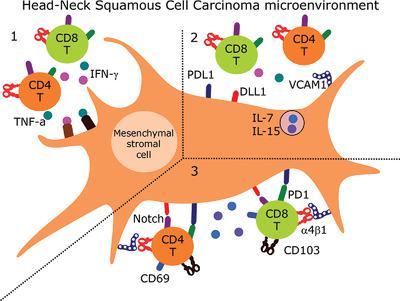当前位置:
X-MOL 学术
›
Eur. J. Immunol.
›
论文详情
Our official English website, www.x-mol.net, welcomes your
feedback! (Note: you will need to create a separate account there.)
Human T cells interacting with HNSCC-derived mesenchymal stromal cells acquire tissue-resident memory like properties.
European Journal of Immunology ( IF 4.5 ) Pub Date : 2020-05-22 , DOI: 10.1002/eji.202048544 Alessio Mazzoni 1 , Laura Maggi 1 , Gianni Montaini 1 , Matteo Ramazzotti 2 , Manuela Capone 1 , Anna Vanni 1 , Luca Giovanni Locatello 1, 3 , Giusi Barra 4 , Raffaele De Palma 4, 5 , Oreste Gallo 1, 3 , Lorenzo Cosmi 1, 6 , Francesco Liotta 1, 6, 7 , Francesco Annunziato 1, 7
European Journal of Immunology ( IF 4.5 ) Pub Date : 2020-05-22 , DOI: 10.1002/eji.202048544 Alessio Mazzoni 1 , Laura Maggi 1 , Gianni Montaini 1 , Matteo Ramazzotti 2 , Manuela Capone 1 , Anna Vanni 1 , Luca Giovanni Locatello 1, 3 , Giusi Barra 4 , Raffaele De Palma 4, 5 , Oreste Gallo 1, 3 , Lorenzo Cosmi 1, 6 , Francesco Liotta 1, 6, 7 , Francesco Annunziato 1, 7
Affiliation

|
Tissue‐resident memory (Trm) cells are specialized components of both CD4+ and CD8+ T cell subsets that persist in peripheral nonlymphoid tissues following infections and provide fast response in case of a secondary invasion by the same pathogen. Trm cells express the surface markers CD69, CD103, and the immune checkpoint molecule PD‐1. Trm cells develop not only in the context of infections but also in tumors, where they can provide a line of defense as suggested by the positive correlation between the frequency of tumor‐infiltrating Trm cells and patients’ survival. Trm cells persistence in peripheral tissues depends on their adaptation to the local microenvironment and the presence of survival factors, mainly IL‐7, IL‐15, and Notch ligands. However, the cell sources of these factors are largely unknown, especially in the context of tumors. Here, we show that head–neck squamous cell carcinoma (HNSCC) is enriched in CD4+ and CD8+ T cells with a Trm phenotype. Moreover, we show that mesenchymal stromal cells that accumulate in HNSCC are a source of survival factors and allow proper expression of Trm‐typical markers in a VCAM1‐dependent manner.
中文翻译:

与HNSCC来源的间充质基质细胞相互作用的人类T细胞获得组织驻留记忆之类的特性。
组织驻留记忆(Trm)细胞是CD4 +和CD8 + T细胞亚群的特殊组成部分,它们在感染后会持续存在于外周非淋巴组织中,并在同一病原体继发侵袭的情况下提供快速响应。Trm细胞表达表面标记CD69,CD103和免疫检查点分子PD-1。Trm细胞不仅在感染的环境中发展,而且在肿瘤中发展,它们可以提供防御线,正如肿瘤浸润的Trm细胞的频率与患者生存之间的正相关性所暗示的那样。Trm细胞在周围组织中的持久性取决于它们对局部微环境的适应性以及生存因子(主要是IL-7,IL-15和Notch配体)的存在。然而,这些因素的细胞来源在很大程度上是未知的,特别是在肿瘤的情况下。这里,我们显示头颈鳞状细胞癌(HNSCC)富含具有Trm表型的CD4 +和CD8 + T细胞。此外,我们表明,在HNSCC中积累的间充质基质细胞是生存因子的来源,并允许以VCAM1依赖的方式正确表达Trm型标志物。
更新日期:2020-05-22
中文翻译:

与HNSCC来源的间充质基质细胞相互作用的人类T细胞获得组织驻留记忆之类的特性。
组织驻留记忆(Trm)细胞是CD4 +和CD8 + T细胞亚群的特殊组成部分,它们在感染后会持续存在于外周非淋巴组织中,并在同一病原体继发侵袭的情况下提供快速响应。Trm细胞表达表面标记CD69,CD103和免疫检查点分子PD-1。Trm细胞不仅在感染的环境中发展,而且在肿瘤中发展,它们可以提供防御线,正如肿瘤浸润的Trm细胞的频率与患者生存之间的正相关性所暗示的那样。Trm细胞在周围组织中的持久性取决于它们对局部微环境的适应性以及生存因子(主要是IL-7,IL-15和Notch配体)的存在。然而,这些因素的细胞来源在很大程度上是未知的,特别是在肿瘤的情况下。这里,我们显示头颈鳞状细胞癌(HNSCC)富含具有Trm表型的CD4 +和CD8 + T细胞。此外,我们表明,在HNSCC中积累的间充质基质细胞是生存因子的来源,并允许以VCAM1依赖的方式正确表达Trm型标志物。











































 京公网安备 11010802027423号
京公网安备 11010802027423号